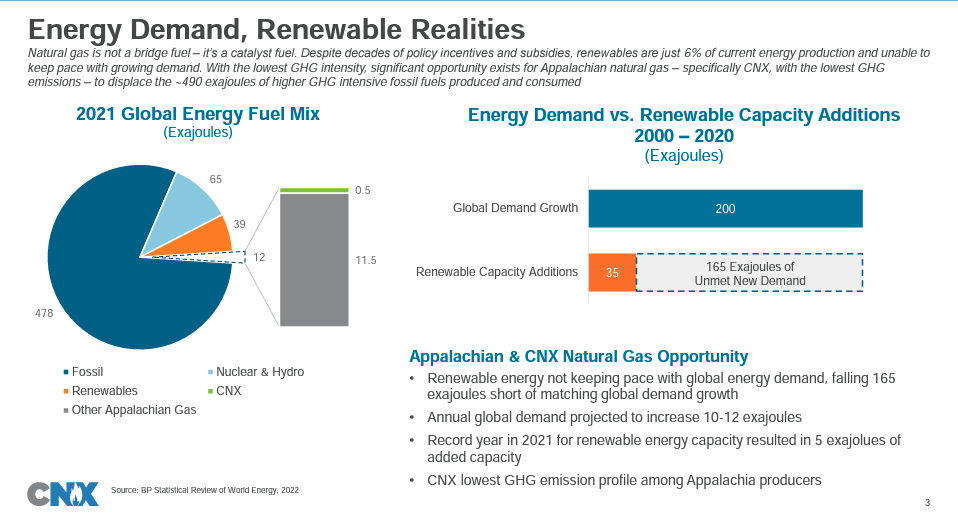Natural gas as a catalyst fuel for the sustainable energy revolution
In CNX's most recent earnings call, CEO Nick DeIuliis detailed how natural gas is an immediate solution for helping industries lower costs and emissions.
July 28, 2022

The following was paraphrased from Nick Deiuliis’ introductory comments from CNX Resources’ Second Quarter 2022 Earnings Conference Call, held Thursday, July 28, 2022. For his full remarks, click here.
Global Perspective on Energy Production and Consumption
The world currently produces roughly 600 exajoules of energy annually, which includes approximately 39 exajoules from renewable energies related to wind, solar, and geothermal. Said differently, only 6% of current energy production is derived from renewable energy despite decades of policy incentives and subsidies. Twenty twenty-one was a record year for renewable energy installation, yet resulted in only 5 exajoules of renewable energy added to overall global energy production.
On the consumption side, forecasts indicate that world energy demand will grow on average around 2% per year, which is approximately 10 to 12 exajoules per year. During the last 20 years, world energy demand has grown by roughly 200 exajoules, and over the same time approximately 35 exajoules of renewable energy capacity has been added.
Renewables have a long way to go to simply meet new demand before they have any hope of displacing oil and coal in a meaningful way. More low-cost and environmentally-friendly Appalachian natural gas can help meet this growing demand and make progress now on environmental goals.
Of the 600 exajoules of world energy production, fossil fuels account for over 490 exajoules of that total, with hydro accounting for 40, nuclear adding 25 more, and then the 39 EJ of wind/solar renewables to get to approximately 600.
A majority of fossil fuel production is oil and coal. Appalachian natural gas only accounts for approximately 12 exajoules, or roughly 2% of total global energy production, and represents the cleanest, lowest greenhouse gas intensive fossil fuel. Within Appalachia, CNX accounts for 0.5 exajoules and has the lowest GHG intensity and cost structure in the basin.

We Are the Solution
CNX serves as a needed ally as the world seeks to reduce the other 490 exajoules of much higher GHG intensive fossil fuels and help keep pace with new energy demand.
Supply chain – CNX and Appalachia are closest to the major U.S. demand centers for energy, goods, and services, allowing our local energy to be even more greenhouse gas-efficient from an all-in, scopes 1-3, life cycle perspective. Reducing unnecessary shipping logistics is the elephant in the room when it comes to emissions.
Utilization of our low-greenhouse-gas-intensive natural gas and its derivative products will rely on infrastructure that works with new green technologies when and if they are ready and able to be deployed to meet future demand. This means that engines and factories can run off 100% compressed natural gas (CNG), 100% hydrogen, or related blends. The same logic applies to additional electric vehicle (EV) deployment, as natural gas turbines on the grid allow electrification to play a more meaningful role sooner.
Our New Technologies team has numerous projects in various phases of development which will help the world move to a lower GHG emitting future, while also maintaining reliable energy resources for a properly functioning society.
The New Technologies team is commercializing technology that will produce low-carbon-footprint natural gas, derivative products, and associated environmental attributes. These technologies are a game changer for the natural gas extraction and transportation industries. Technology and assets from CNX can help displace higher carbon intensive fuels in the US energy mix, both on the power grid and in the transportation sector.
These displacement opportunities are over 100 billion cubic feet per day of natural gas opportunities in the U.S. alone. More products and services could be produced within the Appalachian region.
Innovation in CNG and LNG
CNX is using in-house proprietary technology to disrupt various industries currently relying on other less-efficient and higher-emitting forms of energy. This technology efficiently transforms the state of natural gas from gaseous phase into CNG and LNG. That CNG and liquefied natural gas (LNG) on [well pad] can transform the aviation and ground transportation industries. Instead of off-shore, high carbon footprint, high-cost gasoline for ground transportation, the ability exists to use local, low carbon footprint, low-cost CNG. It’s a similar story for aviation, with LNG replacing jet fuel.
The business case for this comes down to common sense. If [you] want to lower global GHG emissions, you deploy new renewable energy in the sunniest and windiest places that still rely on coal and oil, to displace them. You don’t place renewables at scale in places like Pennsylvania where the efficiencies are low, the costs at scale are high, the supply chains are thousands of miles in length, and the life cycle carbon footprints are going in the wrong direction.
What is better for the planet, for greenhouse gas emissions, for the regional economy, and for business models? Making products overseas using coal fired power and inefficient power plants and factories, that utilize poor labor practices, and having all that wasted cost and energy transporting these products all the way to America? Or, simply manufacturing these products here with low carbon-footprint natural gas, more efficient power plants and factories, using local well-paid workers and shipping it within a one-day drive? Pretty simple.
